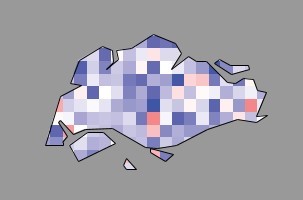Imaging FCS - SPIM
Imaging FCS has multiplexing capabilities attributed to the availability of light sheet based illumination schemes such as single plane illumination microscopy (SPIM). It provides intrinsic z-sectioning of the sample, in combination with the use of array detectors (EMCCD/sCMOS cameras) whose dimension of a single pixel provides the xy sectioning of individual observation volume (SPIM-FCS). Such a multiplexed system allows for simultaneous recording of multiple autocorrelation functions (ACFs) in each pixel over a large region of interest. This enables direct measurements of concerted dynamics over large spatial scales in live samples as opposed to single point measurements conducted in conventional FCS instruments.
In particular, SPIM-FCS has the ability to extend its multiplexing capability to the 3-dimensional (3D) environment due to the nature of its illumination scheme. In SPIM, a micrometer thin, diffraction-limited laser light sheet is created by the combination of a cylindrical lens with a low numerical aperture (NA) illumination objective which offers optical sectioning by illuminating only the plane being detected. By means of moving the entire 3D sample in the z-direction of the detection objective using precise microscope stages, we are able to conduct 3D SPIM-FCS measurements by measuring at multiple planes of the sample. Such 3D information may provide important insights to dynamic biological processes which occur in the 3D environment.

Fluorescent particles that enter the light sheet will emit photons which are then recorded on a fast, sensitive camera. On the right the signal from two different pixels is seen. The fluorescent peaks contain information about the concentration of particles in the sample and their mobility (the wider the fluorescent peaks the slower do the particles move). This information can be extracted by autocorrelation functions.
Beads were injected into the vein of living zebra fish embryo and studied by SPIM-FCS. The autocorrelations (raw data-grey, fitted curve–black) were fitted and D and N were obtained. To identify the direction of flow, 4 different cross-correlations were performed. The velocity in magnitude and direction is depicted as arrow plots.

3D maps of Intensity (1st column), D (2nd column), chi squared (3rd column), N (4th column) for RhoPE labeled DOPC:DOPG (10:1) GUV. The z positions indicate the distance from the upper membrane of the GUV. Representative ACFs (5th column) are displayed for each z position of their corresponding points indicated on the intensity image.
References
1. Sankaran, J.; Shi, X.; Ho, L.Y.; Stelzer, E.H.; Wohland, T. ImFCS: a software for imaging FCS data analysis and visualization, Opt Express, 18 (2010) 25468-25481.
2. Singh, A.P.; Krieger, J.W.; Buchholz, J.; Charbon, E.; Langowski, J.; Wohland, T. The performance of 2D array detectors for light sheet based fluorescence correlation spectroscopy, Optics Express, 21(7) (2013) 8652-8668.
3. Ph. D thesis: Anand Pratap Singh: Light sheet based fluorescence correlation and cross-correlation spectroscopy for quantitative measurements of bio-molecules in live cells
4. Sezgin E, Azbazdar Y, Ng XW, Teh C, Simons K, Weidinger G, Wohland T, Eggeling C, Ozhan G. Binding of canonical Wnt ligands to their receptor complexes occurs in ordered plasma membrane environments. FEBS J. 2017 Jun 19.
5. Ng XW, Teh C, Korzh V, Wohland T. The secreted signaling protein wnt3 is associated with membrane domains in vivo: a SPIM-FCS study. Biophys J. 2016 Jul 26;111(2):418-29.


